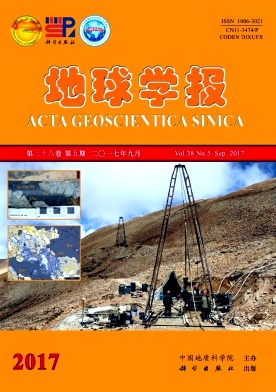LI Hai-feng, TANG Ju-xing, DING Shuai, LI Zhuang, HU Gu-yue, XIE Fu-wei, ZHOU Hui-lin, YANG Zong-yao, SHI Shuo. Fluid Inclusion Study and Stable Isotope Characteristics of the Sinongduo Ag-Pb-Zn Deposit, Tibet[J]. Acta Geoscientica Sinica, 2017, (5): 670-686. doi: 10.3975/cagsb.2017.05.08
| Citation: |
LI Hai-feng, TANG Ju-xing, DING Shuai, LI Zhuang, HU Gu-yue, XIE Fu-wei, ZHOU Hui-lin, YANG Zong-yao, SHI Shuo. Fluid Inclusion Study and Stable Isotope Characteristics of the Sinongduo Ag-Pb-Zn Deposit, Tibet[J]. Acta Geoscientica Sinica, 2017, (5): 670-686. doi: 10.3975/cagsb.2017.05.08
|
Fluid Inclusion Study and Stable Isotope Characteristics of the Sinongduo Ag-Pb-Zn Deposit, Tibet
-
Abstract
The Sinongduo silver-lead-zinc (gold) polymetallic deposit is located on the southern side of Longge'er–Gongbujiangda arc fault belt of the Lhasa terrane. It is the first discovered low sulfidation epithermal type deposit in the middle of the Pb-Zn-Ag metallogenic belt on the northern margin of Gangdise. The orebody occurs in the volcanic rocks of the Linzizong Group, and is controlled by the secondary northwest faults formed by the northwest volcanic activity. The mineralization process can be divided into five stages: illite-sericite-chalcedony-jasper±iron-man carbonates (I); quartz-pyrite±galena±sphalerite (II); galena-sphalerite- quartz-pyrite-sericite±silver minerals±carbonate (III); argentite-peaceite-galena±pyrargyrite±sphalerite±chalcopyrite (IV); and quartz±carbonates±sericite (V). In this paper, systematic studies of fluid inclusions from 34 samples of stage III and 12 samples of stage V and Si-H-O isotopes of inclusions were conducted. Based on the previous research, this paper discussed the nature and source of mineralization and the mechanism of mineralization precipitation. Three types of fluid inclusions were distinguished in various kinds of quartz and sphalerite of the main ore-forming period in this deposit, which primarily include the pure liquid (PL), liquid-rich two-phase (WL) and gas-rich two-phase (WG) inclusions. There are only PL and WL types in the late barren quartz-vein. The homogenization temperatures, salinities and densities of the quartz in stage III vary from 185.6℃ to 290.7℃, 1.57% NaCl eqv to 5.71% NaCl eqv and 0.76 g/cm3 to 0.92 g/cm3, respectively. The homogenization temperatures, salinities and densities of the sphalerite in stage III vary from 197.2℃ to 280.8℃, 1.22% NaCl eqv to 5.71% NaCl eqv and 0.75 g/cm3 to 0.99 g/cm3, respectively. The homogenization temperatures, salinities and densities of the quartz in stage V vary from 147.6℃ to 218.7℃, 2.07% NaCl eqv to 8.94% NaCl eqv and 0.88 g/cm3 to 0.98 g/cm3, respectively. Ore-forming fluids are characterized by low temperature, low pressure and low density. The gas composition of the quartz inclusions of stage III mainly consists of H2O and CO2. The cations in the liquid phase of the quartz inclusions of stage III are mainly Ca2+ and K+, and the anions are mainly SO2– 4, Cl– and F–. Theδ30Si distribution range of the ore-forming fluid is –0.2‰~0.1‰, theδD value is between –151‰ and –177‰, and theδ18OH2O value is between –5.02‰ and –0.63‰. The results of Si-H-O isotope studies show that the ore-forming fluids are mainly atmospheric water. Large quantities of CO2, SO2– 4, F– and other acidic gases and ionic components in the inclusions indicate that the the inclusions still retain the characteristics of weak magmatic water. The ore-forming fluid in stage III is immiscible fluid and the fluid boiling is the main mechanism of enrichment and mineralization of metallic materials in the Sinongduo epithermal deposit.
-

-
-
Access History







 DownLoad:
DownLoad: